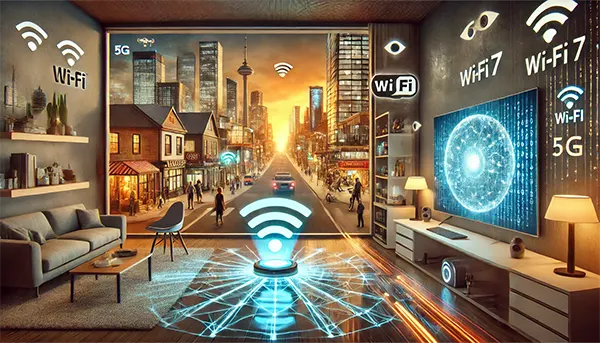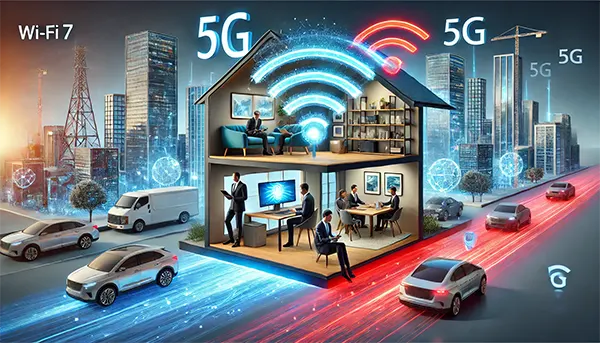5G vs. Wi-Fi 7: What to Choose for Home and Business in 2025?

In 2025, two cutting-edge wireless technologies—5G and Wi-Fi 7—dominate discussions about connectivity. Both offer lightning-fast speeds and improved reliability, but they serve different purposes. Understanding their advantages and limitations is crucial for choosing the best option for home or business use.
Understanding 5G and Wi-Fi 7: Key Features
5G is the latest generation of cellular technology, offering low latency, high-speed internet, and extensive coverage. It enables seamless connectivity across vast areas, making it an ideal solution for mobile users and remote work scenarios.
Wi-Fi 7, on the other hand, is the newest evolution of wireless networking, designed for indoor environments. It provides unprecedented speeds, reduced latency, and improved efficiency for multiple device connections, making it perfect for high-performance networking at home or in offices.
While both technologies promise faster connections, their implementations differ. 5G relies on mobile carriers and infrastructure deployment, whereas Wi-Fi 7 is a local area network (LAN) technology, offering better control and cost-effectiveness for home and office settings.
Speed and Latency: How They Compare
Wi-Fi 7 boasts speeds exceeding 30 Gbps, surpassing 5G’s current peak of around 10 Gbps. This makes Wi-Fi 7 more suitable for ultra-high-bandwidth applications such as cloud gaming and 8K video streaming.
Latency is another crucial factor. Wi-Fi 7 delivers latency below 1 millisecond, ensuring near-instantaneous response times. While 5G also offers low latency, its performance can fluctuate due to network congestion and coverage variability.
For businesses requiring real-time data processing, such as financial trading or industrial automation, Wi-Fi 7 provides a more stable and predictable connection compared to 5G.
Deployment and Coverage: Where Each Excels
5G’s primary advantage lies in its wide-reaching coverage. Cellular networks provide connectivity in urban, suburban, and rural areas, making it an excellent solution for mobile users and businesses operating across multiple locations.
Wi-Fi 7, however, is limited to indoor use but excels in densely populated areas. Offices, stadiums, and shopping centres benefit from its ability to handle multiple simultaneous connections without interference.
Another key consideration is installation. 5G requires a subscription and carrier infrastructure, whereas Wi-Fi 7 can be set up with a high-performance router, offering long-term cost savings.
Security and Reliability: Which is Safer?
Security is a major concern in today’s digital landscape. 5G incorporates advanced encryption and authentication protocols, making it resistant to cyberattacks. However, its dependence on external service providers raises concerns about data privacy and potential network vulnerabilities.
Wi-Fi 7 enhances security with WPA4 encryption, providing robust protection against hacking attempts. Since users control their Wi-Fi networks, they have greater control over security measures, reducing reliance on third-party providers.
For enterprises handling sensitive information, Wi-Fi 7 offers better security customization, while 5G remains a strong choice for businesses requiring encrypted mobile communication.

Best Use Cases: Home vs. Business
For home users, Wi-Fi 7 is the preferred choice due to its superior speed and stability. It supports smart home devices, high-definition streaming, and cloud gaming without interruptions.
Businesses with mobile workforces benefit from 5G’s seamless connectivity. Logistics, transportation, and outdoor event management industries rely on 5G’s extensive coverage and mobility.
In hybrid work environments, a combination of both technologies is ideal. Employees can use Wi-Fi 7 for in-office productivity while relying on 5G for remote work and travel.
Cost Considerations: Which is More Affordable?
Wi-Fi 7 requires an initial investment in compatible routers and access points, but once installed, there are no recurring costs apart from standard internet service fees.
5G, however, involves subscription fees and potential data caps, which can increase costs for businesses with high bandwidth needs. Carrier pricing structures may also vary based on location and usage.
For cost-conscious users, Wi-Fi 7 offers better long-term value, while 5G remains a viable option for businesses prioritising mobility and flexibility.
